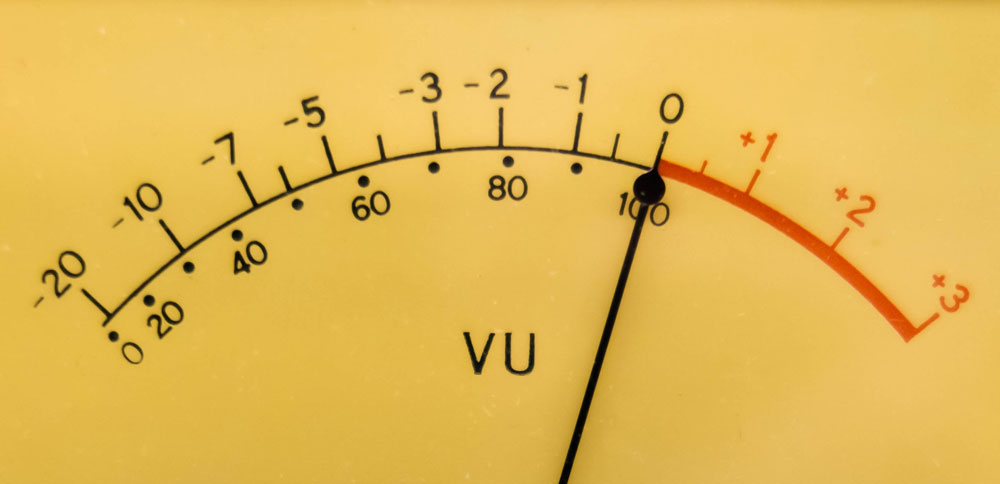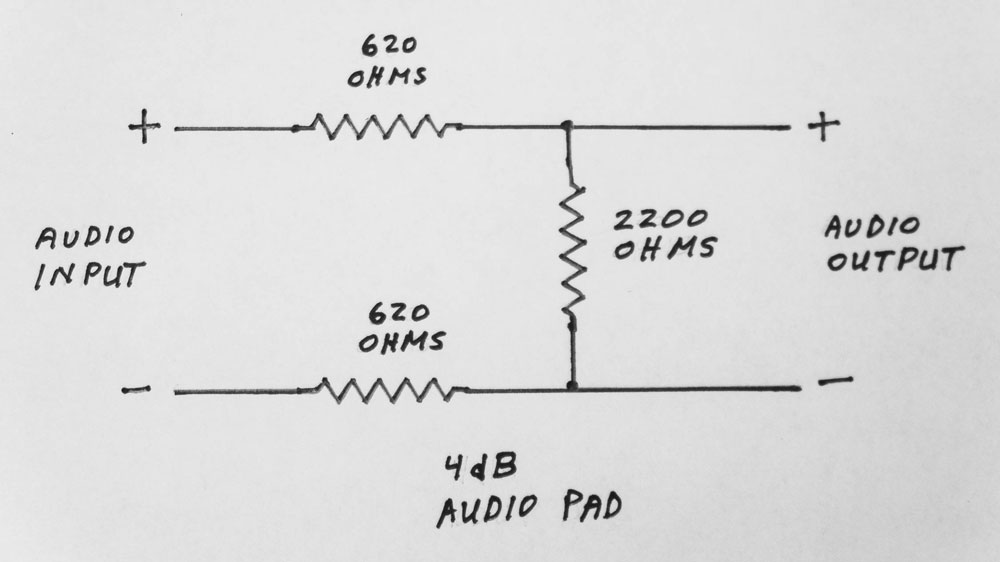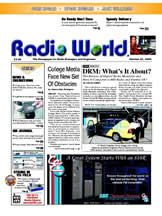tablishing
and keeping to a standard audio level, especially in studios,
has been a problem since the first radio station went on the
air.
Back in
the 1960s, audio console output levels were usually +8 dBm
(eight decibels above one milliwatt into 600 ohms) for tube and
early solid-state consoles. That +8 was a compromise between
headroom and noise. A
1969 vintage Gates Statesman audio console had 74 dB of dynamic
range between peak clipping at +18 dBm and the noise level.
That makes 64 dB between
normal program level and noise.
It was fine for AM stations were a signal to noise ratio
of only 45 dB was FCC required between 100% modulation and no
audio.
Then came
FM with an FCC required 60 dB or better signal to nose ratio in
the entire audio chain.
The Statesman’s 64 dB signal to noise left only 4 dB for
additional noise in the station audio before it could not make
FCC specs.

Fig. 1: Voice audio with high peaks
Fig. 1
shows an oscilloscope view of a normal voice where there is just
enough dynamic range to accommodate it.
Vertical peaks are just at the equipment limits.
I prefer an oscilloscope to see exactly when peak
clipping occurs.
There is a discussion of this in a November 9, 2016, article I
wrote in Radio World titled Calibrate Analog Audio Consoles.
If you
are following the numbers, you will realize there was only 10 dB
between 100% (0 dB on the meter as seen in Fig. 2) and audio
clipping. The same
microphone and voice sounded different from one audio console to
another depending on the voice and the operator running the
controls.

Fig. 2: An analog VU meter indicating
0VU.
My
testing of audio, with an oscilloscope fifty years ago, showed
that some voices can have as much as a 16 dB average to peak
ratio. From that I
deduced that ALL audio consoles need their analog VU meters
calibrated to show 100% when peak clipping occurs 20 dB higher.
The extra 4 dB takes care of audio when operators let
levels run hot.

Fig. 3: High peak-to-average ratio
with clipping.
Fig. 3
shows audio driven into peak distortion.
Not all people hear peak clipping distortion - that
grungy/tearing sound added to the original content.
Women listeners are the
first to tune out.
Ouch!
Recalibrating a meter to fix that on an older console meant
maybe -2 dBm output level when the VU meter said 100%.
The signal to noise ratio would then be degraded by 10
dB. Those with good
ears would say the audio was not distorted, but there was there
was hiss in the background. Which
one is more acceptable?
Hi-Fi
home stereo systems were gaining popularity in the 1960s and had
better audio fidelity than what broadcasters could provide.
No wonder there was a push to design and build better
audio consoles, especially for classical stations.
For rock and roll listeners of the day, distortion and
hiss hardly mattered because the sound was just loud!
Audio
quality improved when integrated circuits, such as the NE5532N,
hit the market.
These and similar operational amplifier chips make it possible
to send and receive balanced audio without the need for
transformers. As you
know, even the best transformers color the sound of audio a bit.
While that coloration may
be desirable and sought after in some recording studio settings,
the goal is generally to keep a broadcast air chain as clean as
possible. Doing without transformers solved that problem.
ICs can
deliver about +24 dBm. The
specified normal output level on most consoles, using this
technology, is +4 dBm, which yields 20 dB of headroom.
Typical examples are the
Radio Systems RS-12A and Arrakis 150 through 12,000 series audio
consoles. That 20dB
is necessary to help protect from peak clipping when operators
like to hear mechanical VU meter needles “click” as they drive
the audio hard and the needles into the peg.
There is still 80 dB or more between normal program level
and the noise floor. We’ve
come a long way!
Audio
processing has been helpful in fixing audio level problems but
can do little for distortion.
Although, I understand some newer digital processors
attempt to de-clip audio by mathematically recreating the
original waveforms.
This is a problem which shouldn’t exist in the first place if
proper procedures are followed.
Once the audio is clipped, it is permanently damaged.

Fig. 4: High asymmetry with positive
clipping.
Taking a
step back in time to the early 1960s, there was the aptly named
Gates Level Devil that expected +8 input but could be adjusted
to work on low level audio for up to 25 dB of gain boost or
reduction. It fixed
a lot of problems caused by inattentive operators.
The goal was to keep audio levels constant for ease of
listening. One story
from back then told of a minister who came into a radio station
to do a live radio program and insisted the Level Devil be taken
out of the circuit when HE was on the air!
As far as
audio levels go, console inputs of the 1960s were designed to
accommodate a fairly wide range of source material through the
use of input attenuators.
There was no standard, as I recall.
Cartridge and reel to reel tape decks might be capable of
0 dBm but could easily be turned down to match what a console
channel happened to be optioned for.
A phono/turntable preamplifier might deliver only -15
dBm.
I was
constantly reminding operators to watch audio levels to keep the
sound consistent because I could hear audio level problems when
listening on the air.
Operators, as you know, use their ears, under tightly
pressed headsets to determine audio quality, rather than being
bothered to read VU meters.
They do not realize the listener doesn’t have the same
headsets.
Automobile environments are a special listening challenge with
maybe only 15 dB of listening range above the noise while on a
busy highway. It is
a lousy deal when a listener has to turn the radio volume up and
down while hearing radio audio should have come in at a
consistent level.
Try it
yourself
Put an oscilloscope
on voice audio in a studio so you to see what you are hearing or
observe the waveform in a digital editor.
Intentionally record a voice at an audio level that is
too high. You will
hear the peak clipping distortion, caused by running audio
beyond the limits of the equipment, and you will understand that
more is not better.
Digital
Levels
What is
standard when recording digitally?
On some devices, the LED VU meter reads -14 dBFS (14 dB
below full scale) when audio is normal.
On an Axia Radius
console, meters change from green to yellow at -20 dBFS and from
yellow to red at -10 dBFS. They are peak reading so that
helps. Average
reading meters will not tell the story.
When meters touch the red, there is 10 dB of digital
headroom. You might
need that or more headroom for an occasional peak.
Remember that 0 dBFS is an absolute limit, and digital clipping
is even more destructive than analog. At that point there are no
more bits left to represent the signal.
Since
noise is no longer an issue, I highly recommend -20 dBFS as a
digital reference level for +4 dBm or 0 VU in the analog world,
especially when you think that noise might be at -90 dB or more.
It is embarrassing and inexcusable to let audio go into
audible peak clipping distortion that ruins an otherwise great
sound.
I have
toured radio studios and watched LED VU meters indicating
anything between a consistent -20 and over-the-top red lined.
I’ll bet listeners hear that and tune away.
They don’t know why; they just find another station.
Yes, it
is true that today’s audio processors do a fairly good job in
fixing audio level problems.
However, it is up to the production staff and engineers
to keep the station plant running so the processing can do its
job properly when fed with consistent audio input levels.
Audio
pads
The
original +8 dBm standard evolved to +4 dBm and now 0 dBm on some
studio devices. Many,
but not all, analog audio routing switches have audio level
controls. If the
ones you encounter do not, then you should install resistive
audio pads to bring higher level sources down to match the
lowest level in the facility. Fig.
5 shows a simple balanced audio pad.
It assumes the audio source has a low drive impedance and
all devices being fed by it are bridging (10K ohm or higher
input impedance). The
values chosen are standard and are ¼ watt or larger resistors.
Make it variable by
substituting a 5000-ohm variable resistor for the 2200-ohm fixed
resistor.

Fig. 5: Schematic of a 4 dB balanced
audio pad.
A tiger
by the tail
Today,
many studios have a mix of traditional analog on punch blocks
and Studio Hub on Cat 5.
The next step is AoIP (Audio over Internet Protocol).
Audio levels can get out of hand if all sources are not
matched.
What
about podcasts?
They typically come to me without any audio
processing and often have 10 dB or more disparities between
voices during an interview.
Some operators deliberately adjust audio level to
emphasize a point. This
doesn’t go well when listening in a car with high ambient noise.
No listener should have
to crank the volume up and down to follow the content.
I’ve also noticed a 10 dB
or more level difference from one podcast to another and even
different episodes from the same source.
Automobile manufacturers should look into simple audio
processing for non-processed material like podcasts and CDs.
That could enhance the user experience in a noisy road
environment.
Summary
Again, consistency is the key to good audio.
Take pride in the sound of the facilities you work on.
Radio depends on keeping listeners.
Mark
Persons, WØMH is an SBE Certified Professional Broadcast
Engineer and is now retired after more than 60 years in radio
broadcast engineering, including 44 years in business. He
started by turning the dials of broadcast transmitters at age 11
and stays active by mentoring four radio broadcast engineers.
Mark is also a member of the National Radio Systems
Committee. His website is
www.mwpersons.com.
Comment
on this or any article. Write to
radioworld@nbmedia.com.



